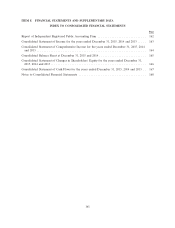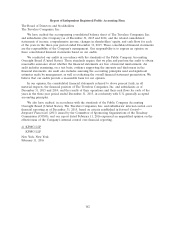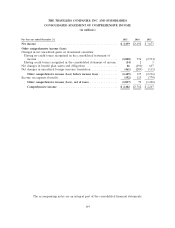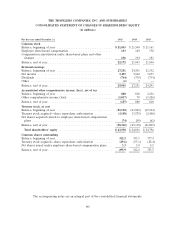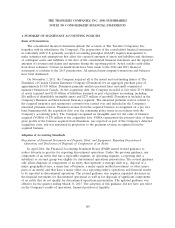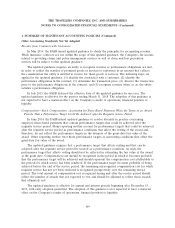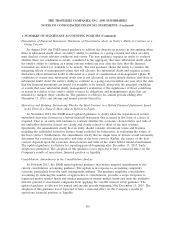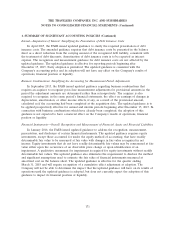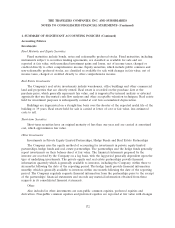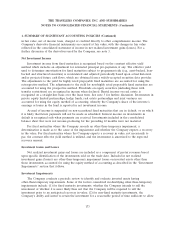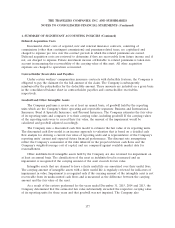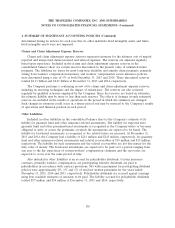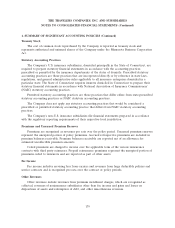Travelers 2015 Annual Report Download - page 169
Download and view the complete annual report
Please find page 169 of the 2015 Travelers annual report below. You can navigate through the pages in the report by either clicking on the pages listed below, or by using the keyword search tool below to find specific information within the annual report.THE TRAVELERS COMPANIES, INC. AND SUBSIDIARIES
NOTES TO CONSOLIDATED FINANCIAL STATEMENTS (Continued)
1. SUMMARY OF SIGNIFICANT ACCOUNTING POLICIES (Continued)
Other Accounting Standards Not Yet Adopted
Revenue from Contracts with Customers
In May 2014, the FASB issued updated guidance to clarify the principles for recognizing revenue.
While insurance contracts are not within the scope of this updated guidance, the Company’s fee income
related to providing claims and policy management services as well as claim and loss prevention
services will be subject to this updated guidance.
The updated guidance requires an entity to recognize revenue as performance obligations are met,
in order to reflect the transfer of promised goods or services to customers in an amount that reflects
the consideration the entity is entitled to receive for those goods or services. The following steps are
applied in the updated guidance: (1) identify the contract(s) with a customer; (2) identify the
performance obligations in the contract; (3) determine the transaction price; (4) allocate the transaction
price to the performance obligations in the contract; and (5) recognize revenue when, or as, the entity
satisfies a performance obligation.
In July 2015, the FASB deferred the effective date of the updated guidance by one year. The
updated guidance is effective for the quarter ending March 31, 2018. The adoption of this guidance is
not expected to have a material effect on the Company’s results of operations, financial position or
liquidity.
Compensation—Stock Compensation: Accounting for Share-Based Payments When the Terms of an Award
Provide That a Performance Target Could Be Achieved after the Requisite Service Period
In June 2014, the FASB issued updated guidance to resolve diversity in practice concerning
employee share-based payments that contain performance targets that could be achieved after the
requisite service period. Many reporting entities account for performance targets that could be achieved
after the requisite service period as performance conditions that affect the vesting of the award and,
therefore, do not reflect the performance targets in the estimate of the grant-date fair value of the
award. Other reporting entities treat those performance targets as nonvesting conditions that affect the
grant-date fair value of the award.
The updated guidance requires that a performance target that affects vesting and that can be
achieved after the requisite service period be treated as a performance condition. As such, the
performance target that affects vesting should not be reflected in estimating the fair value of the award
at the grant date. Compensation cost should be recognized in the period in which it becomes probable
that the performance target will be achieved and should represent the compensation cost attributable to
the periods for which service has been rendered. If the performance target becomes probable of being
achieved before the end of the service period, the remaining unrecognized compensation cost for which
requisite service has not yet been rendered is recognized prospectively over the remaining service
period. The total amount of compensation cost recognized during and after the service period should
reflect the number of awards that are expected to vest and should be adjusted to reflect those awards
that ultimately vest.
The updated guidance is effective for annual and interim periods beginning after December 15,
2015, with early adoption permitted. The adoption of this guidance is not expected to have a material
effect on the Company’s results of operations, financial position or liquidity.
169




